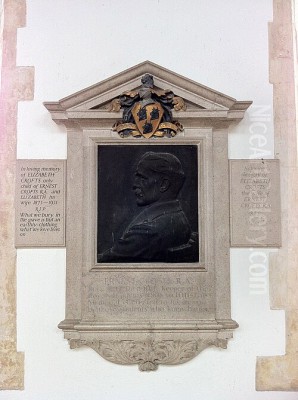
Ernest Crofts stands as a significant figure in British art history, particularly noted for his dedication to depicting military and historical scenes during the late Victorian and Edwardian periods. A painter whose reputation rested on meticulous detail and dramatic compositions, Crofts captured pivotal moments from British and European history, bringing battles and historical figures to life for a contemporary audience fascinated by the past. His work, primarily associated with the Royal Academy of Arts, reflects both the academic traditions of his time and a personal commitment to historical accuracy.
Early Life and Artistic Formation
Born in Leeds, England, on September 15, 1847, Ernest Crofts hailed from a family with notable connections. His father was John Crofts, a Justice of the Peace, and his mother, Ellen Wordsworth, was a poet and related to the celebrated Romantic poet William Wordsworth. This connection to the literary world perhaps hinted at the narrative and historical interests that would later define Ernest's artistic career. His early education took place at Rugby School, one of England's leading public schools, suggesting a privileged upbringing.
Following his schooling at Rugby, Crofts did not immediately pursue art in England. Instead, he travelled to Berlin, where he initially intended to follow a different path. However, his artistic inclinations soon led him to Germany's renowned art centre, Düsseldorf. He enrolled to study art there, immersing himself in the traditions of the Düsseldorf School, which was famous for its detailed historical and genre painting. This period in Germany, lasting several years, proved formative, instilling in him a rigorous approach to technique and subject matter.
Upon returning to London, Crofts continued his artistic training under the tutelage of Alfred Bryan Clay (often cited as A.B. Clay), a painter known for his historical subjects. Clay's guidance likely reinforced Crofts's inclination towards narrative painting. Furthermore, Crofts gained invaluable, albeit harrowing, firsthand experience related to his future specialization. He witnessed aspects of the Franco-Prussian War (1870-1871), including visiting the battlefields around Metz. This direct exposure to the aftermath of conflict undoubtedly informed the realism and detail found in his early military paintings.
Emergence at the Royal Academy
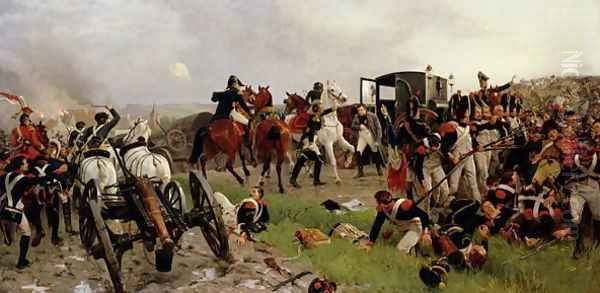
The Royal Academy of Arts in London was the preeminent institution for artists in Britain during the 19th century. Acceptance into its annual exhibitions was crucial for establishing a reputation, and election to its membership was the highest honour. Crofts made his debut at the Royal Academy exhibition in 1874 with a painting titled A Retreat: Episode in the Franco-German War. This work, likely drawing on his recent experiences, immediately signalled his interest in military themes.
His debut was successful, and Crofts quickly became a regular and respected exhibitor at the Academy. The following year, 1875, he exhibited Ligny, a depiction of the battle fought just before Waterloo. This painting further cemented his reputation as a promising historical painter and was subsequently shown at the Philadelphia International Exhibition, gaining him international exposure. Another notable early work exhibited was On the Evening of the Battle of Waterloo (1879), showcasing his focus on the Napoleonic era.
Crofts's rising prominence was formally recognized by the Royal Academy. He was elected an Associate of the Royal Academy (ARA) in 1878, a significant step towards full membership. This election placed him among the ranks of established artists like Sir John Everett Millais, Lord Leighton, and Sir Lawrence Alma-Tadema, who dominated the Academy walls during this period. Crofts continued to exhibit historical and military scenes, steadily building his portfolio and reputation within the London art world.
Artistic Style and Subject Matter
Ernest Crofts developed a distinct artistic style characterized by meticulous attention to detail, historical accuracy, and dramatic, often action-filled, compositions. His primary focus was on military history, particularly the Napoleonic Wars and the English Civil War, although he also depicted scenes from other conflicts like the Thirty Years' War. He was renowned for his painstaking research into the historical periods he painted.
This research often involved studying authentic uniforms, weaponry, and equipment from the relevant eras. He was known to collect historical artefacts to use as props and references in his studio. Furthermore, Crofts believed in understanding the terrain of the battles he depicted. He visited significant historical sites, including the battlefield of Waterloo, to ensure the topographical accuracy of his settings. This dedication lent an air of authenticity to his work that was highly valued by Victorian audiences.
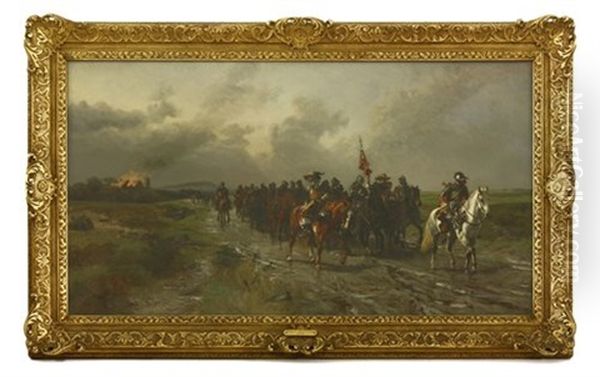
His paintings typically feature complex arrangements of figures, capturing moments of intense action, strategic decision-making, or poignant aftermath. Whether depicting cavalry charges, infantry formations, or solemn historical events like The Funeral of King Charles I, Crofts aimed for a narrative clarity that made the historical moment accessible and engaging. His style remained largely academic, favouring clear rendering and careful composition over the looser brushwork and atmospheric effects being explored by Impressionists like Claude Monet or Edgar Degas in France.
Crofts's commitment to detail extended to the nuances of military life and the human element within the grand scale of war. While battles were his forte, he also painted quieter moments, such as soldiers resting or commanders conferring, adding depth to his portrayal of historical events. His work provided a visual chronicle that resonated with a public deeply interested in Britain's military past and its role on the world stage, competing in popularity with other military painters like the acclaimed Lady Butler (Elizabeth Thompson).
Key Works and Themes
Throughout his career, Ernest Crofts produced a substantial body of work, much of it centred on pivotal moments in military history. His paintings often focused on British involvement in major European conflicts, reflecting the patriotic sentiments prevalent in the Victorian era.
The Napoleonic Wars were a recurring theme. Ligny (1875) and On the Evening of the Battle of Waterloo (1879) were early successes. Perhaps his most famous work on this subject is Napoleon's Last Attack at Waterloo (also known as The Last Stand or similar variations, exhibited around 1895). This painting captures the dramatic climax of the battle, showcasing Crofts's ability to handle large-scale, complex scenes filled with figures and action. He returned to Waterloo frequently, depicting various stages and aspects of the engagement.
The English Civil War provided another rich source of material. Crofts painted numerous scenes from this conflict, often focusing on key figures and battles. Works like Oliver Cromwell at Marston Moor, Prince Rupert at Marston Moor, Ironsides Returning From Sacking a Cavalier House, Hampden Riding Away From Chalgrove Field, Roundheads Victorious, and To the Rescue illustrate his fascination with this turbulent period of British history. His depictions often highlighted the distinct appearances and military tactics of the Cavaliers and Roundheads.
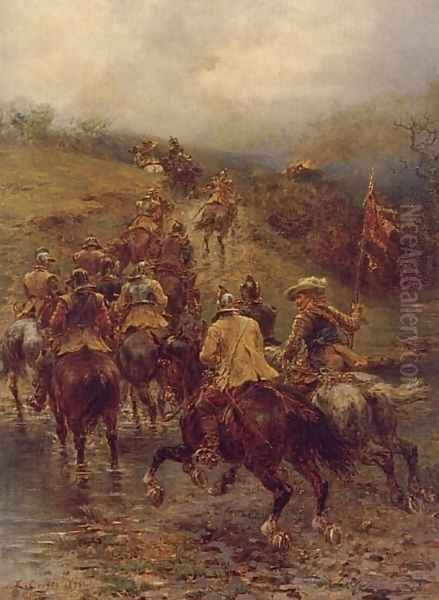
Crofts also explored broader historical themes. Wallenstein: A Scene of the Thirty Years War tackled a major European conflict less commonly depicted by British artists. His portrayal of King Charles I On His Way To Execution (exhibited 1883) and The Funeral of King Charles I (exhibited 1890, depicting the burial at Windsor) are sombre, powerful images that capture the tragedy of the deposed monarch. These works demonstrate his versatility within the historical genre, moving beyond the battlefield to moments of political and personal drama. Another work, Whitehall, January 30th, 1649, directly referenced the execution itself.
The Keeper of the Royal Academy
In 1896, Ernest Crofts achieved the distinction of being elected a full Royal Academician (RA), cementing his status within the British art establishment. Two years later, in 1898, he was appointed to the significant position of Keeper of the Royal Academy. He held this post until his death in 1911. The Keeper was responsible for overseeing the Royal Academy Schools, managing the students, and maintaining discipline and standards within the institution's educational arm.
This role placed Crofts at the heart of the academic art world in Britain. He succeeded Philip Hermogenes Calderon and was followed by Charles Sims. As Keeper, he resided within Burlington House, the home of the Royal Academy. His responsibilities involved not only administration but also providing guidance and instruction to the next generation of artists studying at the RA Schools. This position required considerable dedication and reflected the high esteem in which he was held by his fellow Academicians.
His tenure as Keeper coincided with a period of transition in the art world. While the RA, under Presidents like Sir Edward Poynter (who succeeded Millais), still upheld traditional academic values, new movements and styles were challenging the established order. Crofts, through his role, represented the continuity of the academic tradition, emphasizing draughtsmanship, composition, and historical subject matter, even as Impressionism, Post-Impressionism, and early Modernism were gaining ground elsewhere. His position ensured his influence extended beyond his own canvases to the training of young artists.
Reputation, Criticism, and Later Years
During the 1870s and 1880s, Ernest Crofts enjoyed considerable popularity and critical acclaim. His detailed and dramatic historical paintings resonated with Victorian tastes for narrative art and historical subjects. His works were frequently reproduced as engravings, reaching a wide audience beyond the gallery walls. His election as ARA and then RA, followed by his appointment as Keeper, attests to his high standing within the official art world of his time. He was considered one of the leading historical painters in Britain, alongside contemporaries like Andrew Carrick Gow and Briton Rivière, who also tackled historical and animal subjects with detailed realism.
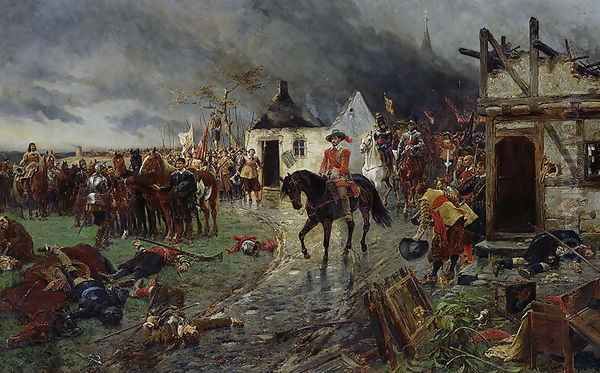
However, towards the end of his career and posthumously, his reputation began to wane. Artistic tastes started shifting away from the detailed academic style he represented. The rise of Modernism brought new aesthetic values that often dismissed Victorian narrative painting as illustrative or overly sentimental. Some critics began to find his work lacking in deeper artistic insight or emotional resonance, focusing perhaps too much on surface detail.
A specific instance of criticism arose concerning a large painting commissioned by King Edward VII depicting the funeral procession of Queen Victoria. While a prestigious commission, the resulting work was reportedly criticized, possibly for being overly dramatic or perhaps failing to capture the solemnity of the occasion adequately in the eyes of some observers. There was also a recorded, rather harsh, contemporary critique suggesting his work lacked "redeeming talent," indicating that even during his lifetime, his highly detailed style was not universally admired, perhaps seen by some as laborious rather than inspired, contrasting with the perceived genius of figures like George Frederic Watts or the decorative elegance of Albert Moore.
Despite this later decline in critical favour, Crofts remained a respected figure, particularly within the Royal Academy, until his death. He continued to paint and fulfil his duties as Keeper. He passed away at Burlington House, London, on March 19, 1911, at the age of 63. His death marked the end of a career dedicated to the academic tradition and the genre of historical military painting.
Legacy and Influence
Ernest Crofts's legacy lies primarily in his contribution to the genre of British historical and military painting during the late 19th century. His works provide a detailed and dramatic visual record of key moments in British and European history, particularly warfare. His commitment to accuracy in uniforms, equipment, and settings set a high standard for historical illustration within the academic tradition. For students of military history and material culture, his paintings remain valuable resources.
While his direct influence on the major currents of 20th-century art was limited due to the shift towards Modernism, his work likely inspired subsequent painters specializing in military subjects who valued realism and historical detail. His approach can be seen as part of a broader European tradition of military painting, exemplified by French artists like Jean-Louis-Ernest Meissonier and Édouard Detaille, who also enjoyed immense popularity for their detailed battle scenes. Crofts successfully adapted this continental interest in military precision to British historical subjects.

Although many of his paintings are now less well-known than those of some of his RA contemporaries like Leighton or Millais, major works are held in public collections in the UK, including the Royal Academy itself, the Leeds Art Gallery, and other regional museums. His work serves as an important example of the tastes and values of the Victorian art world, particularly its fascination with history, narrative, and meticulous realism.
In conclusion, Ernest Crofts was a dedicated and highly skilled practitioner of historical military painting. His education in Düsseldorf and London, his firsthand experiences related to the Franco-Prussian War, and his meticulous research informed a career spent vividly reconstructing the past on canvas. As a prominent member and Keeper of the Royal Academy, he upheld the academic tradition, contributing significantly to the visual culture of his time through his detailed and dramatic depictions of conflict and history. While artistic fashions changed, his work endures as a testament to a specific era of British art and a lifelong dedication to chronicling the past with accuracy and flair.